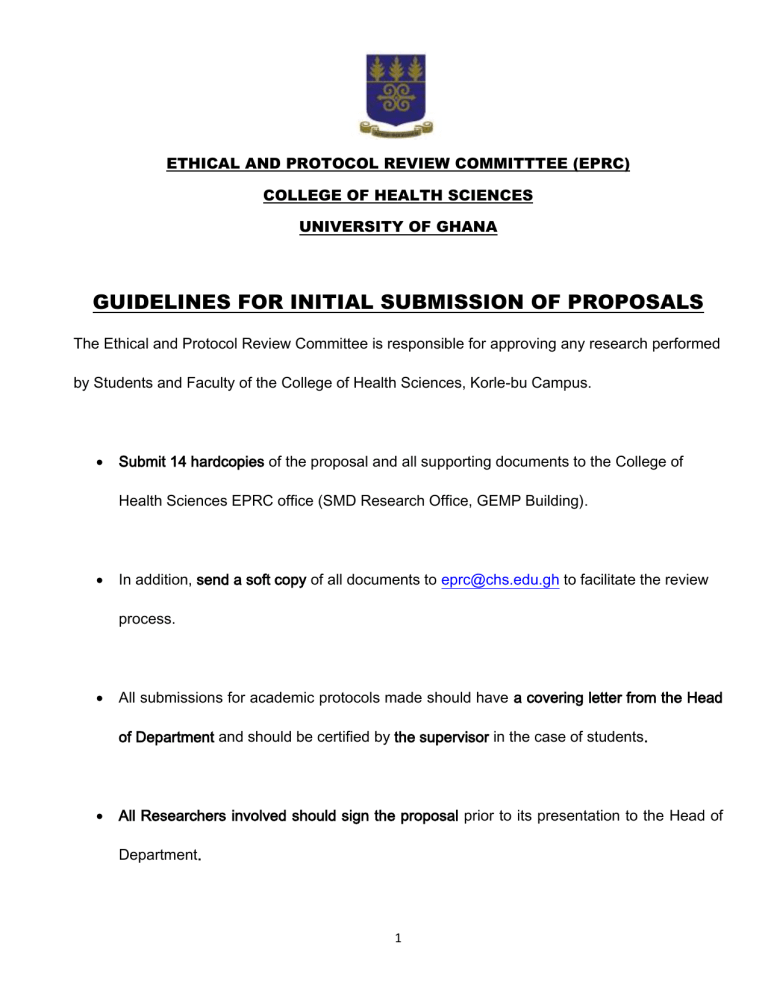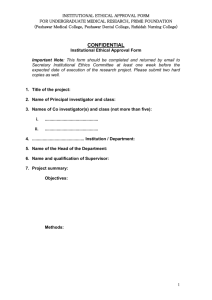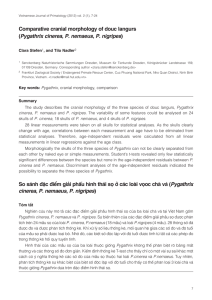ETHICAL AND PROTOCOL REVIEW COMMITTTEE (EPRC

ETHICAL AND PROTOCOL REVIEW COMMITTTEE (EPRC)
COLLEGE OF HEALTH SCIENCES
UNIVERSITY OF GHANA
GUIDELINES FOR INITIAL SUBMISSION OF PROPOSALS
The Ethical and Protocol Review Committee is responsible for approving any research performed by Students and Faculty of the College of Health Sciences, Korle-bu Campus.
Submit 14 hardcopies of the proposal and all supporting documents to the College of
Health Sciences EPRC office (SMD Research Office, GEMP Building).
In addition, send a soft copy of all documents to eprc@chs.edu.gh
to facilitate the review process.
All submissions for academic protocols made should have a covering letter from the Head
All Researchers involved should sign the proposal prior to its presentation to the Head of
Department. of Department and should be certified by the supervisor in the case of students.
1
Proposal should have a Font of size 12 and line spacing of 1.5.
A proposal coming from outside the College of Health Sciences, Korle-bu attracts a processing fee.
THE PROTOCOL SUBMITTED TO THE COMMITTEE SHOULD BE IN THE FOLLOWING
SECTIONS
(Protocols with Uncompleted sections will not be considered for review)
TITLE PAGE
This page should have the following;
Title of Protocol:
Principal Investigator: (Name, Qualification (Specialty), Institution and Department, Postal
Address, Telephone, Fax Number, E-mail Address)
Co-PIs: (Name, Qualification (Specialty), Department, Postal Address, Telephone, Fax number, E-mail Address)
Prior Scientific Review: (Attach Letter of Approval)
Prior Ethical and Protocol Review: (Name any other Ethical and Protocol review board/committee this proposal has been submitted to and attach approval letter if applicable. In case of rejection, state reasons)
Collaborating Institutions: (Attach Letter of Approval)
2
Source/s of Funding: (Name and Address)
STRUCTURED ABSTRACT (1 page maximum and must not have references)
Background
General Aim
Methodology
Expected Outcome (expected results or what you hope to achieve from study)
BACKGROUND (1-3 pages maximum)
Introduction
Problem statement:
Statement of problem which requires research.
Problem definition from the available data/literature/statistics
Incidence and prevalence of the problem
Distribution of the problem –geographical, population group, etc
Possible explanations for the problem
Justification/Relevance
Why the problem requires research-
Potential impact/contribution of the research to health or policy.
Hypothesis (if applicable)
3
The expected association/relationship between one or more independent variables and the dependent variable which the study will establish.
Aim (s)
What is expected to be achieved? Proposal must typically have one or two broad aim (s).
Specific Objectives
Proposal may have several immediate or specific objectives. This describes the specific action or experiment(s) that will be undertaken to achieve the broad aim(s).
LITERATURE REVIEW (5 pages maximum)
METHODOLOGY (8 pages maximum)
Study design:
Human studies- could be retrospective (case-control), prospective (cohort, clinical trial, case-control) or cross-sectional.
Study sites
Describe site briefly including facilities available
Subjects/study population
4
Inclusion/exclusion criteria
List inclusion and exclusion criteria separately.
Sample size determination
Use appropriate Power Calculations for type of study
Procedures to be used
Data collection methods and instruments.
Should be reproducible by other investigators
Needs to be precise.
Data handling
May include
Coding
Quality control (pre-testing, supervision, training) measures.
Data security and confidentiality
Statistical analysis
Descriptive statistics (frequency, central tendencies, associations)
Inferential statistics (test of means, correlation coefficient, etc)
DISSEMINATION OF RESULTS
5
To Project sponsors and policy makers (where applicable)
At workshops, seminars and conferences
In different types of publications
ETHICAL ISSUES
For Human Subjects o Consider Recruitment and sampling procedures, Potential risks and benefits, confidentiality. o For vulnerable subjects (children, pregnant women, institutionalized subjects), state how subjects’ protection will be ensured. o Provide Consent Form with simple and clear language.
For Vertebrate Animals o Justification for use of animals o Housing and veterinary care o Processes to minimize discomfort o Euthanasia
REFERENCES
Use either Harvard or Vancouver Style. Must choose one and must be consistent
6
TIMELINES/WORK SCHEDULE
This is usually in the form of a Gantt chart (to show different activities versus time frames for expected completion).
PERSONNEL OF THE STUDY TEAM INCLUDING PERCENTAGE EFFORT
Role of each member ( Not applicable for students)
BUDGET & LOGISTICS
To be detailed even if no external funding is required.
APPENDIX
Consent Form
Data Collection Instrument (eg. Questionnaire, if applicable)
Letters of Support (if applicable)
Principal Investigator’s CV (not applicable to students)
Any other attachments
7
NOTE:
As the Principal Investigator / Co-investigator / Researcher on this project, your signature on the proposal confirms that:
1.
You will ensure that all procedures performed under the study will be conducted in accordance with all relevant policies and regulations that govern research involving human participants.
2.
You understand that if there is any change from the project as originally approved you must submit an amendment to the CHS-EPRC for review and approval prior to its implementation. Where you fail to do so, the amended aspect of the study is invalid.
3.
You understand that you will report all serious adverse events associated with the study within seven days verbally and fourteen days in writing.
4.
You understand that you will submit progress reports each year for review and renewal.
Where you fail to do so, the CHS-EPRC is mandated to terminate the study upon expiry.
5.
You agree that you will submit a final report to the CHS-EPRC at the end of the study.
Revised February, 2015
8








